Briefly: In our opinion, speculative short positions (150% of the full position) in gold, silver and mining stocks are justified from the risk/reward point of view.
Yesterday’s session was full of very important and coherent signs – if one knows what signs to monitor, that is. Let’s move right to them.
Let’s start with the long-term USD Index chart (charts courtesy of http://stockcharts.com).
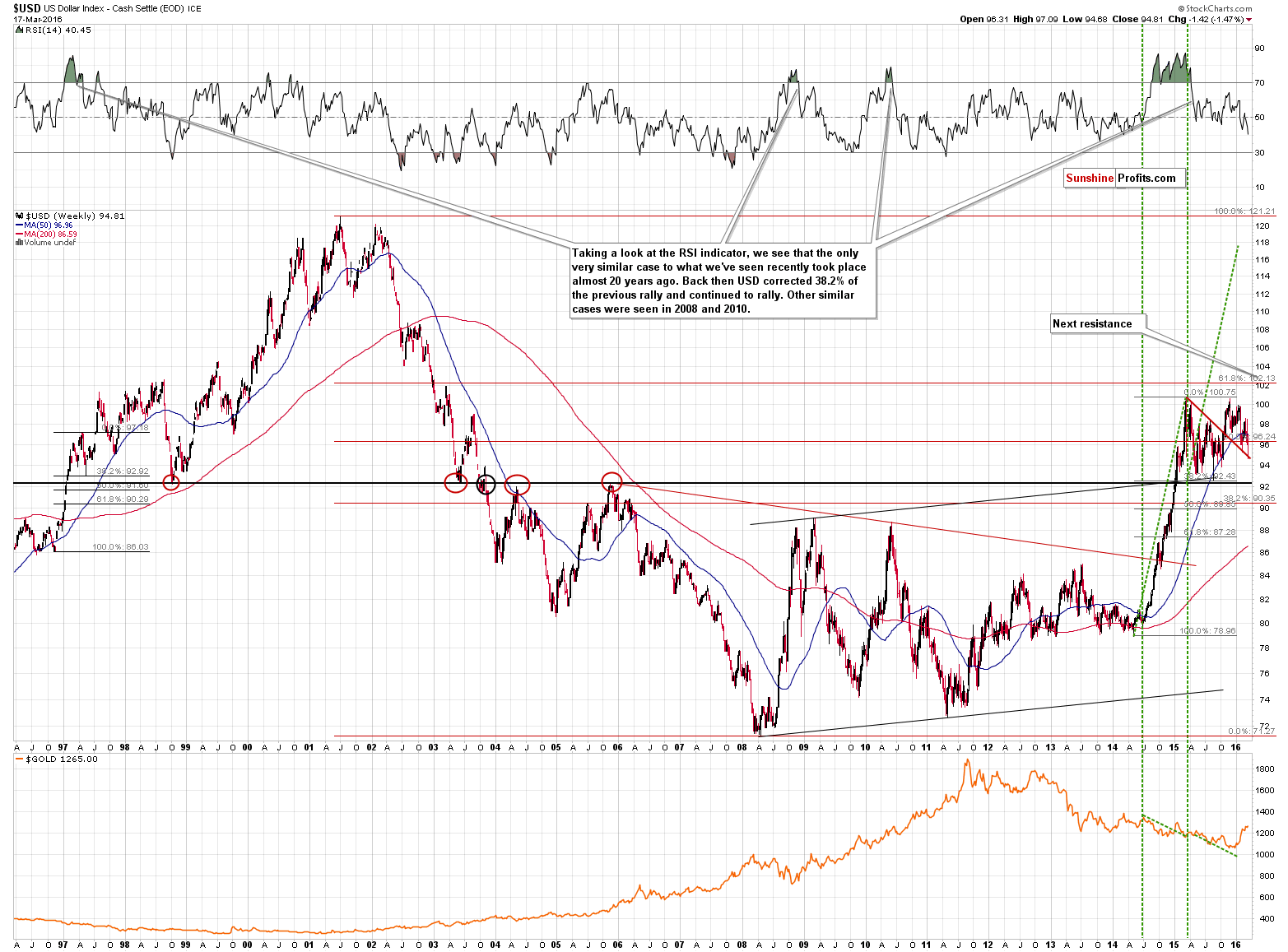
Yesterday, we commented on the above chart in the following way:
The most important thing visible on the above chart is that the USD Index is in a major uptrend, and more precisely in a consolidation within it. After breaking through the resistance of 92, the USD Index has been consolidating – and that’s perfectly natural, because the previous rally was both: big and sharp.
Once the consolidation is over, the move that follows it is likely to be similar to the one that preceded it (note the green lines on the above chart) and this implies a huge rally in the coming months (likely later in 2016).
The question is when the current consolidation is going to end and the answer is based on the support levels. First of all, we don’t expect the 92 level to be broken, so even if USD slides much lower, it doesn’t seem likely that it would result in a breakdown. Secondly, the declining, red support line is something that is likely to keep declines in check – this line is more or less being reached at the moment of writing these words.
The USD Index closed more or less at the mentioned red support line without breaking visibly below it, so it seems likely that the decline is over of very close to being over.
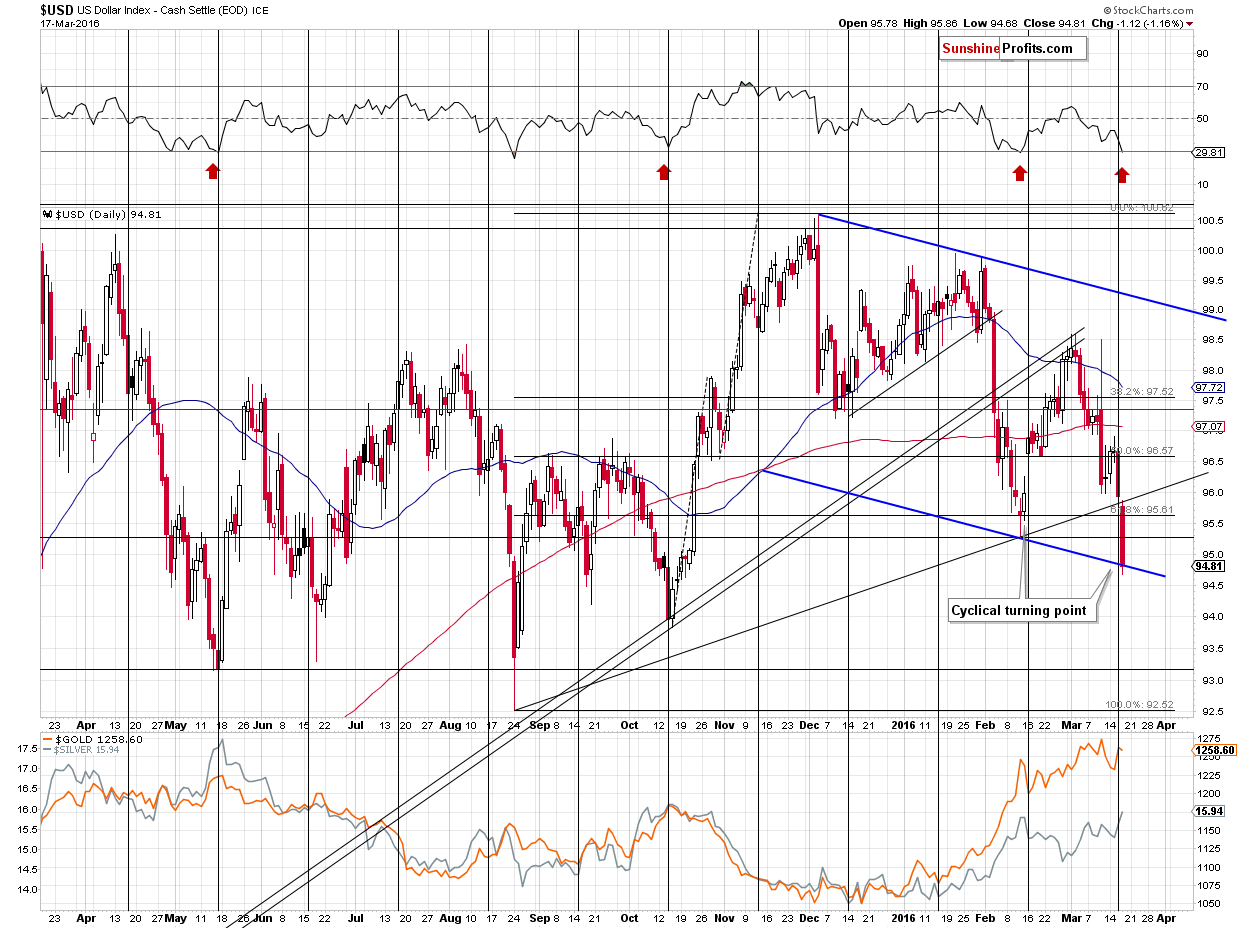
As far as the short-term USD Index chart is concerned, we described it yesterday in the following way:
The USD Index moved to the rising support line yesterday, but this line was broken in today’s pre-market trading, so the question is what is the next level that could trigger a bounce or a rally.
The February 2016 low and the lower border of the declining trend channel are both good candidates. Since they are relatively close to each other it’s quite likely that either USD will reverse either right at one of them or somewhere in between. This is where the USD Index is right now (slightly above 95).
The USD Index finally closed at the lower border of the declining trend channel, which is in tune with the above. The local bottom is likely in.
We also wrote the following and it remains up-to-date:
There is one additional important factor that should be considered here – the cyclical turning point. Yesterday’s decline took place right at it and today’s move lower is still very close to it. In almost all recent cases, the turning points in the USD Index were followed by rallies and since the most recent move was definitely to the downside it appears likely that the USD Index will move higher relatively soon (perhaps even this week).
All in all, the technical picture for the USD Index is bullish.
Now, how does the announcement regarding the interest rates impact the above? The impacts of all important announcements should be discussed along with discussing the previous expectations. Remember when the Fed lowered rates by 0.75 and the stock market plunged? It was because people were expecting an even bigger cut. It didn’t matter that the rates were lowered dramatically – it only mattered that they were lowered less than market had expected.
What did the market expect of yesterday’s announcement? Pretty much what the Fed delivered. As we are writing in today’s Gold News Monitor, the investors are expecting only one rate hike this year. Consequently, since yesterday’s comments more or less confirmed investors’ expectations, did anything change? On “nominal” level – yes, the Fed said something else than it’s been saying previously, however, on “real” level – how this is likely to impact the markets – not much changed, if anything.
Consequently, yesterday’s news is not likely to have a major impact on the markets, including the USD Index, except for a short-term impact – and this short-term impact (based on yesterday’s and today’s declines) could be already over.
(…)
The medium-term implications remain unchanged for the precious metals sector and they are bearish. The thing that changed was the very short-term outlook in which some investors “discovered” what most investors were expecting all along – no changes in interest rates now and then just one increase in 2016. (…)
The USD Index declined, but the cyclical turning point and the combination of 2 support lines make the short-term outlook bullish, not bearish.
There’s one more thing that we would like to discuss today. The RSI indicator just hit 30 and in all previous situations when this was the case close to the turning point, a big rally followed in the USD and a big decline followed in the precious metals sector.
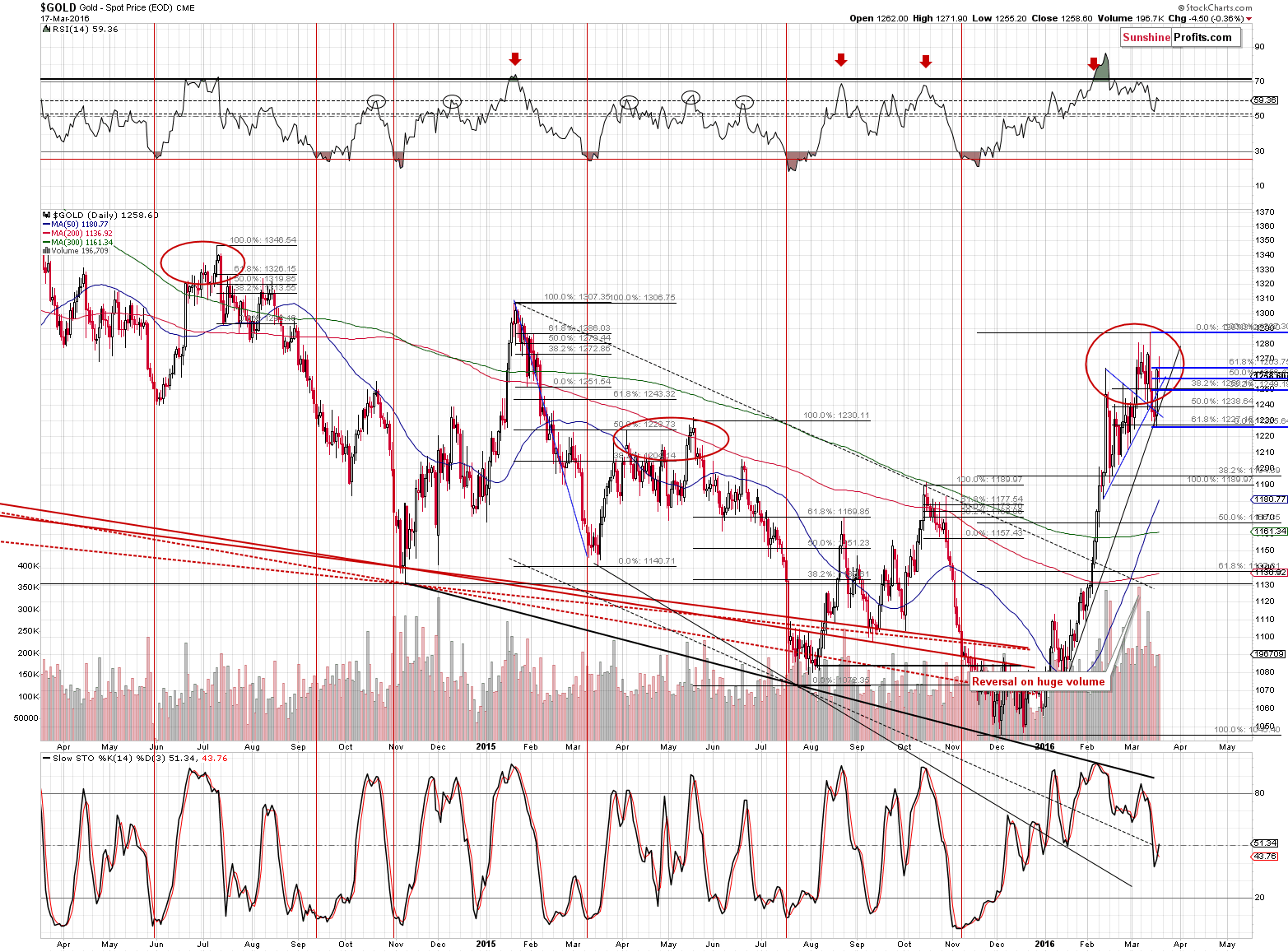
In yesterday’s alert, we commented on the above chart in the following way:
Gold corrected to the 61.8% Fibonacci retracement level (based on the March decline) yesterday and it moved a bit above it in today’s pre-market trading.
There are 2 things that we would like to discuss here. The first thing is the size of the volume – it was low, which is a bearish sign compared to the size of the rally. The second thing is the size of the move. It appears to be huge, but… The USD Index moved below its previous March low and gold didn’t respond similarly.
What’s even more important, the USD Index declined much further in today’s pre-market trading (almost a full index point) and gold rallied a mere $6. Gold appears unwilling to really respond to the bullish signals from the USD Index and since the latter is quite likely to reverse, gold could slide quite far.
The latter was particularly important and bearish, and based on the entire session we know that the strength of the mentioned signal (gold’s underperformance) got even bigger – the USD finally declined some more (and closed more than a full index point lower) while gold reversed and closed about $5 lower. That’s major underperformance and a very strong bearish sign.
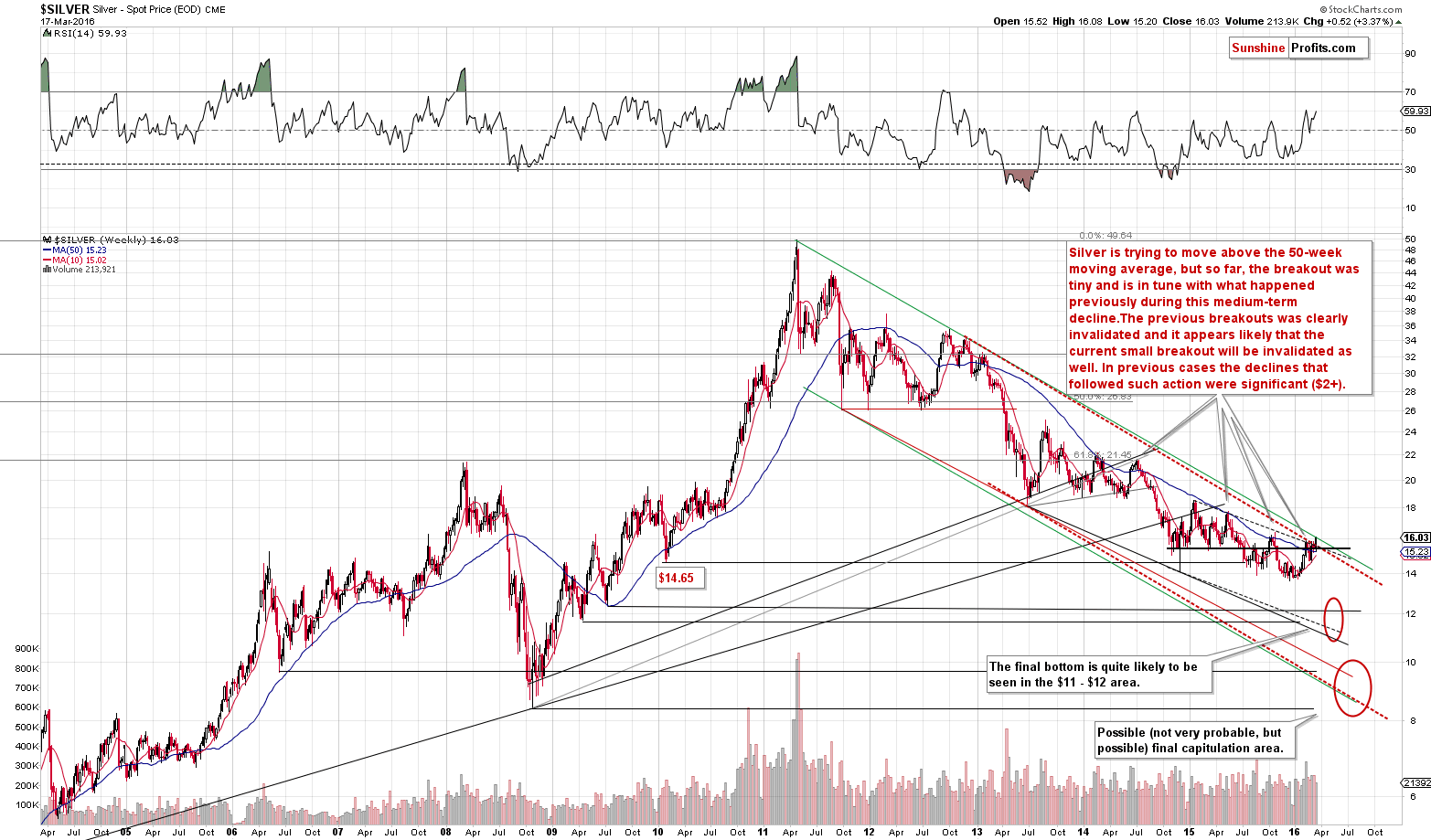
In yesterday’s alert we wrote the following:
The long-term silver chart continues to have bearish implications – the trend remains down from this perspective. Please note that the major resistance line (green line) based on the 2011 and late-2012 tops is right very close to the current price. It’s more or less at the $16 level and silver moved to $15.84 earlier today. It’s quite likely that we will see a reversal close to the current price levels.
The above remains up-to-date. In fact, silver closed at $15.94, after an attempt to break above $16. The outlook remains bearish.
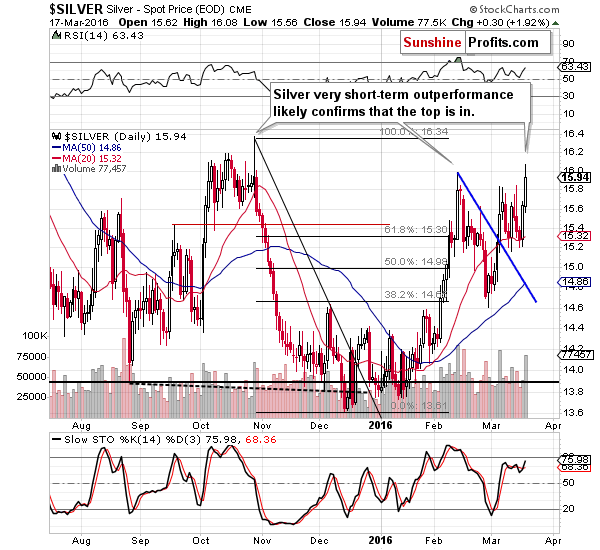
The most bearish thing about silver is that it… rallied. Silver tends to outperform gold on a very short-term basis right at the tops, and thus we view silver’s strong performance along with gold’s very weak performance as a bearish confirmation.
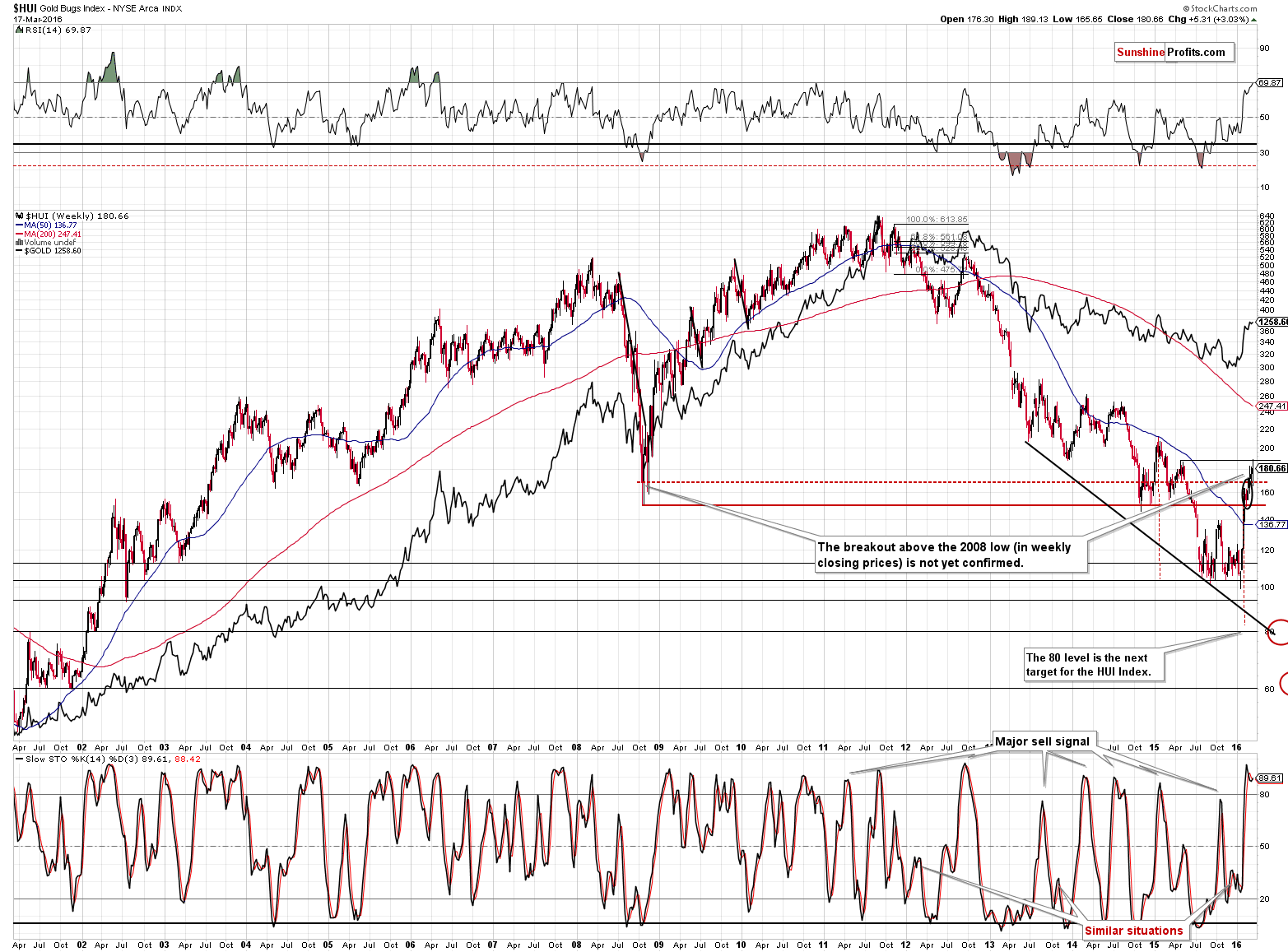
Yesterday, we wrote the following:
The HUI Index moved higher and is about to reach its May 2015 high, which will serve as resistance. In fact, that’s the first strong horizontal resistance that the HUI Index would reach that would come from an important top.
The RSI indicator just moved above 70 and this meant that an important top was in or about to be in on many occasions.
The HUI Index tried to move above the mentioned May 2015 high, but failed to do so and we saw an immediate invalidation of a small breakout above this level. The implications are bearish.
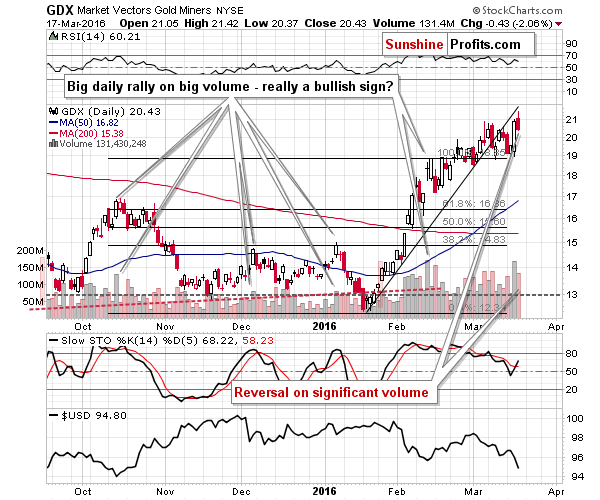
From the short-term point of view, mining stocks formed a reversal on significant volume, which is also a very bearish development, especially given what happened on the previous day. In yesterday’s alert we wrote the following:
(…) mining stocks just rallied on strong volume and closed at new highs. Isn’t this a bullish development that would invalidate all of the above?
It actually isn’t. It is generally said that a move higher on strong volume is a bullish sign for any market, but let’s just take a moment and see what actually happened after similar sessions in the recent months.
In 3 out of 4 similar sessions, this kind of session actually marked a local top. In the fourth case, the most recent one, it was not the top, but still it was followed by a daily downswing. Consequently, applying this “general rule” to mining stocks appears inappropriate – the analogy to the previous situations doesn’t suggest that a rally will follow. It suggests that we’ll see a decline.
Yesterday’s reversal and the miners’ inability to rally despite a rally in the S&P 500 Index and a major decline in the USD Index are a very bearish combination.
Summing up, the situation in the precious metals sector was very bearish based on Wednesday’s session (and yesterday’s alert provides details) and based on yesterday’s session it became even more bearish. We got a combination of multiple bearish confirmations and the short-term outlook got more bearish than it’s been for many months. In fact, we have a hard time recalling the previous time when so many bearish factors and confirmations were in place at the same time. While it’s usually the case that we can get at best a 75%-80% probability of a given move taking place (which means that about a fifth of the very probable moves will not happen), in our opinion it seems that the odds for the decline have now increased even higher – to 85% or so.
Consequently, we think that – even though the position is already full (naturally, this does not mean using the entire trading capital for each trade, let alone the total capital – a full position means using the amount that one decides to use for each trade – like 5% or 15% of the trading capital – you will find more details here) – it’s currently justified to increase the size of the position a bit further (say, to 150% of the general full position). We have never increased the size of the position above the full size before – the reason is that it is very rarely the case that we get so many bearish signs at once and thus the odds for a decline that are so high.
Naturally, the above is connected with taking on additional risk, so this is not for everybody and the above (like everything we write) is not investment advice – just our opinion.
We are also moving the stop-loss for silver a bit higher based on its move up yesterday.
As always, we will keep you – our subscribers – updated.
To summarize:
Trading capital (our opinion): Short positions (150% of the full position) in gold, silver and mining stocks are justified from the risk/reward perspective with the following stop-loss orders and initial target price levels:
- Gold: initial target price: $973; stop-loss: $1,304, initial target price for the DGLD ETN: $90.29; stop-loss for the DGLD ETN $48.27
- Silver: initial target price: $12.13; stop-loss: $16.62, initial target price for the DSLV ETN: $71.92; stop-loss for DSLV ETN $36.89
- Mining stocks (price levels for the GDX ETF): initial target price: $9.34; stop-loss: $22.57, initial target price for the DUST ETF7.60: $; stop-loss for the DUST ETF $2.16
In case one wants to bet on junior mining stocks' prices (we do not suggest doing so – we think senior mining stocks are more predictable in the case of short-term trades – if one wants to do it anyway, we provide the details), here are the stop-loss details and initial target prices:
- GDXJ ETF: initial target price: $14.13; stop-loss: $31.23
- JDST ETF: initial target price: $14.14; stop-loss: $4.05
Long-term capital (our opinion): No positions
Insurance capital (our opinion): Full position
Plus, you might want to read why our stop-loss orders are usually relatively far from the current price.
Please note that a full position doesn’t mean using all of the capital for a given trade. You will find details on our thoughts on gold portfolio structuring in the Key Insights section on our website.
As a reminder – “initial target price” means exactly that – an “initial” one, it’s not a price level at which we suggest closing positions. If this becomes the case (like it did in the previous trade) we will refer to these levels as levels of exit orders (exactly as we’ve done previously). Stop-loss levels, however, are naturally not “initial”, but something that, in our opinion, might be entered as an order.
Since it is impossible to synchronize target prices and stop-loss levels for all the ETFs and ETNs with the main markets that we provide these levels for (gold, silver and mining stocks – the GDX ETF), the stop-loss levels and target prices for other ETNs and ETF (among other: UGLD, DGLD, USLV, DSLV, NUGT, DUST, JNUG, JDST) are provided as supplementary, and not as “final”. This means that if a stop-loss or a target level is reached for any of the “additional instruments” (DGLD for instance), but not for the “main instrument” (gold in this case), we will view positions in both gold and DGLD as still open and the stop-loss for DGLD would have to be moved lower. On the other hand, if gold moves to a stop-loss level but DGLD doesn’t, then we will view both positions (in gold and DGLD) as closed. In other words, since it’s not possible to be 100% certain that each related instrument moves to a given level when the underlying instrument does, we can’t provide levels that would be binding. The levels that we do provide are our best estimate of the levels that will correspond to the levels in the underlying assets, but it will be the underlying assets that one will need to focus on regarding the sings pointing to closing a given position or keeping it open. We might adjust the levels in the “additional instruments” without adjusting the levels in the “main instruments”, which will simply mean that we have improved our estimation of these levels, not that we changed our outlook on the markets. We are already working on a tool that would update these levels on a daily basis for the most popular ETFs, ETNs and individual mining stocks.
Our preferred ways to invest in and to trade gold along with the reasoning can be found in the how to buy gold section. Additionally, our preferred ETFs and ETNs can be found in our Gold & Silver ETF Ranking.
As always, we'll keep you - our subscribers - updated should our views on the market change. We will continue to send out Gold & Silver Trading Alerts on each trading day and we will send additional Alerts whenever appropriate.
The trading position presented above is the netted version of positions based on subjective signals (opinion) from your Editor, and the Tools and Indicators.
As a reminder, Gold & Silver Trading Alerts are posted before or on each trading day (we usually post them before the opening bell, but we don't promise doing that each day). If there's anything urgent, we will send you an additional small alert before posting the main one.
=====
Latest Free Trading Alerts:
The recent Fed’s statement on monetary policy was accompanied by the FOMC’s Summary of Economic Projections and Yellen’s press conference. What can we learn from the latter?
Yellen’s March Press Conference and Gold
Comex is the most important gold futures exchange. We invite you to read our today’s article presenting the biggest world paper gold market and find out how Comex really functions and whether the gold determined there is rigged or not.
Comex Gold Rigging – Fact or Myth?
=====
Hand-picked precious-metals-related links:
Why Canada is dumping its gold - and China isn't
New Chinese Gold Benchmark Auction To Differ From London System
Gold Breaking St. Paddy's Day Pattern?
=====
In other news:
Fed That Can't Go It Alone Pulls Carpet From Under Bond Yields
"Fear" Indicator Surges To Record High
Draghi tells EU leaders he can't fix the economy on his own
Brazil in crisis: What happened and what next?
Chart: Deaths of Roman Emperors vs. coinage debasement
=====
Thank you.
Sincerely,
Przemyslaw Radomski, CFA
Founder, Editor-in-chief
Gold & Silver Trading Alerts
Forex Trading Alerts
Oil Investment Updates
Oil Trading Alerts



